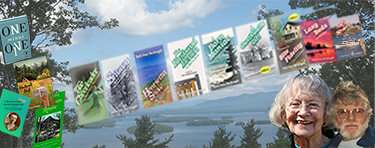
Beginning in 2018 "Ruth's Neighborhood" entries were also posted on Ruth's FACEBOOK page where her entries (usually weekly, on Sunday mornings) lead to lively conversations.
This Page: 2012-2013
2013
SAWYER'S DAIRY BAR
October 11, 2013
In The Cheerleader, Snowy is asked, “How was your summer?” and she replies, “Ice-creamy.”
That’s the way I remember the summer of 1955, when my best friend, Sally, and I worked at Sawyer’s Dairy Bar, across pastures from the Sawyer farmhouse in Gilford, New Hampshire. It was the summer between our sophomore and junior years in high school. We were sixteen, and this was our first job, besides babysitting. Our first official job.
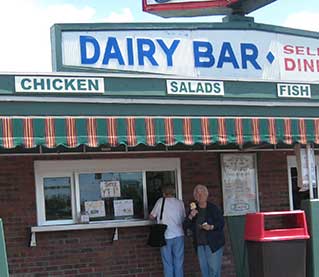 Sawyer’s is still there, in larger form, with a restaurant added on to the original little dairy bar. Each year after Sawyer’s opens for the season, Don and I still go there, and that’s where we were this year on a rainy May 29 for the start of Sawyer’s sixty-eighth season, when a man our age came up to our booth and introduced himself. Larry Litchfield, the new owner.
Sawyer’s is still there, in larger form, with a restaurant added on to the original little dairy bar. Each year after Sawyer’s opens for the season, Don and I still go there, and that’s where we were this year on a rainy May 29 for the start of Sawyer’s sixty-eighth season, when a man our age came up to our booth and introduced himself. Larry Litchfield, the new owner.
Don remarked, “Ruth used to scoop ice cream here.”
Larry Litchfield asked me, “Would you like a job?”
Much amusement! I told him about working here with Sally. He asked if I’d like to see the latest renovations in the old dairy-bar section. Would I?! So Larry took me backstage, into the area where George Sawyer used to make the ice cream and Larry’s wife, Pati, now does. Sawyer’s Dairy had delivered milk out of this part of the building too. I was suddenly disoriented; things had changed, perhaps during the rebuilding after a fire. Then Larry ushered me into the dairy bar and told the young woman at the counter that I used to work here. I added, “The summer of nineteen-fifty-five.” We all laughed about how very long ago that was. Prehistoric to the young woman, I’m sure.
Larry explained that the front wall of the dairy bar had been moved forward to make more space. It sure was roomy compared with the cramped quarters we had worked in, where we’d have to sprawl across the ice-cream cabinets to get to the lemon sherbet or some other not-so-popular flavor at the back.
As I thanked Larry for the tour, I said, “I wish Sally could have been here!” But Sally lives in South Carolina, so I couldn’t have given her a call and told her to rush over to join us.
Back in high school, however, Sally lived near Sawyer’s, on Varney Point on Lake Winnipesaukee. I lived farther away in Laconia, about a twenty-minute drive, and although I had got my driver’s license, my family owned only one car (typical in those days) and thus my mother or father had to drive me to work and pick me up after. So I stayed over at Sally’s even more than usual that summer, and we would walk to work together down the narrow road past cottages and Gilford Beach, in our white nylon uniforms, white nylon aprons, white socks and sneakers. We began work in June after school let out. We didn’t work a full day; the schedule was divvied up amongst Sally and me and two other high-school girls. Our hours varied, sometimes starting in the morning, sometimes in the afternoon. On Fridays Sally and I worked until closing time (eleven o’clock) and had to be back to open up Saturday mornings at ten, with a midday break that sometimes included a swim at Gilford Beach, then back to work until closing. I’d always been an early bird, but for the first time in my life I found myself wanting to sleep late those Saturday mornings.
Ruth Sawyer, George’s wife, a very nice woman with whom I joked about the coincidence of our first name, taught Sally and me how to make change: “Count backward.” I’d been trying to do math in my head, always a challenge, particularly so in this case because the cones cost thirteen cents for a small and seventeen cents for a large, not simpler ten and twenty cents.
In June things were slow enough so we could sit and read between customers. I re
member finishing A Tale of Two Cities at Sawyer’s and walking back to Sally’s house sobbing over “It is a far, far better thing that I do, than I have ever done; it is a far, far better rest that I go to than I have ever known.”
Then came the Fourth of July. We didn’t sit down again. The place was busy. We were always glad if people asked for a hamburger and we could say that we only served ice cream, directing them to a nearby lunch stand. What we lived in dread of was the arrival of busloads of little boys from a nearby summer camp.
When we walked home to Sally’s from work in the evening, our white uniforms would be smeared with ice cream, hot fudge, hot butterscotch. Across the road from Sally’s house was path that was a right-of-way to the lake. On occasion we stopped and went swimming there, stripping to our underwear or skinny-dipping or walking straight into the water in our disgusting uniforms. One time we attracted bloodsuckers. You can imagine the eeks.
The diary entry in One Minus One about working in a dairy bar is of course a fictionalized version of my diary entries that summer.
Don too spent the summer of 1955 involved with dairy products. He worked for Horne’s Dairy in Winnisquam, near Laconia. For him, the summer of 1955 was his summer between high school and college. Horne’s had a dairy bar, very small, but Don didn’t work there; he drove a pickup truck stacked with cases of jangling milk bottles to deliver to customers on a summer-cottages route around Lake Winnisquam. Also cream, buttermilk, cottage cheese, and ice. He made about twenty-five dollars a week, which seemed a fabulous sum to me. I was making twelve-something dollars a week plus tips, of which there weren’t many in a dairy bar. (No paper cup on the counter labeled College Fund back then.) On Saturday nights he’d pick me up after work, laugh at my bedraggled state, and drive me the short distance to Sally’s, where we’d sit in his car in the driveway and discuss the dairy business. And get up to other things, of course. I do remember that we actually did discuss the newfangled homogenized milk as opposed to milk with the cream on top you had to shake in or pour off into a creamer.
Much as I loved staying at Sally’s, the commuting problem made me start thinking of working nearer home the next summer. Sally decided she would like a change, and thus we both got jobs waitressing at a Main Street restaurant, Keller’s, which later became the inspiration for Sweetland in The Cheerleader. Sally’s commute was the same as during the school year; her parents would drop her off at my house on their way to work. So Sally and I still walked to our summer job together. And thanks to Keller’s soda fountain, the summer of 1956 was also ice-creamy.
© 2013 by Ruth Doan MacDougall; all rights reserved
WHY CLIMB A MOUNTAIN
June 13, 2017
This entry was expanded into an introduction to two hiking guides written by Ruth Doan MacDougall, continuing a series originated by her father Daniel Doan. That essay is HERE.
PENNY'S CATS
March 13, 2013
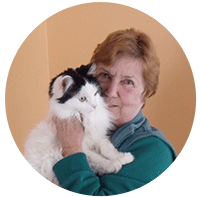 My sister, Penny, has always had a cat in her life.
My sister, Penny, has always had a cat in her life.
Because she was so young (two years younger than I am), she can’t remember our earliest family felines, the barn and house cats at the chicken farm in Belmont, New Hampshire. I only remember one, my first childhood memory that’s now a memory of a memory, a fierce battle-scarred barn cat looking in my bedroom window when I awoke from a nap. But we both remember our mother’s stories about those house cats, mainly the cat she was especially fond of, named Cleora.
From the farm, we moved into town, Laconia, with black-and-white Millicent, who eventually produced black-and-white kittens, all of whom were distributed to homes in the neighborhood except for one male. I named him Kit, thanks to a Christopher coincidence: he was born on Columbus Day, and our folks were reading us one of those “twins” books from the library, Lucy Fitch Perkins’s Dutch Twins, Christopher and Katrina, nicknamed Kit and Kat. Kit seemed a fine name for a kitten. However, although I named him I wasn’t all that interested in him—or cats in general. Penny was.
Kit became her first cat. She dressed him in dolls’ clothes; she pushed him in a doll carriage; she draped him around her shoulders and wore him as a make-believe mink stole. He never scratched her. He grew to be a big heavy cat, but little Penny lugged him everywhere. Our mother taught us both how to cut up, with kitchen shears, raw kidney for his meals—eek, yuck!—and Penny didn’t gag as much as I did.
Penny grew up to be a landscape designer, and her life has continued to be shared with cats. Also dogs. Readers of The Cheerleader will have recognized Snowy’s cat, Kit. When we were kids we also had a dog, a Shetland collie named Annie Laurie, like Snowy’s. Laurie was Penny’s as well. Years later, after a mostly golden retriever named Ben, she had another Shetland collie, this one named Thistle. I’ve forgotten some of the names of all the cats, but I recall Malice (a Siamese) and Negative (black).
In the 1990s, Penny began to escape Maine winters by driving to Florida or Arizona in her car with her dog and cat—sometimes cats. One year I flew out to Arizona to join her for a week, and when she shifted bases from a friend’s house in Mesa to a showplace she was house-sitting for another friend near the Mexican border, we laughed over how there was barely room for her dear old sister in the Subaru Impreza because it was occupied by her latest dog, a female Lhasa apso named Seaweed (who caused more amusement because I never could look at this canine dust mop without bursting out laughing) and two cats in two carriers.
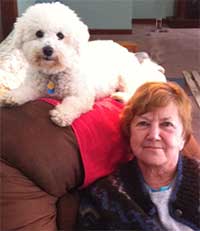 This sort of travel with animals presented the obvious problems about staying in motels, stopping at restaurants, and such. The obvious answer was an RV, and when the year 2000 rolled around, Penny celebrated it by acquiring one. She was down to one cat then, a photogenic white-and-black cat named Phoenix. The dog was still Seaweed. Off went Phoenix and Seaweed with Penny in the RV each winter to warmth and sunshine.
This sort of travel with animals presented the obvious problems about staying in motels, stopping at restaurants, and such. The obvious answer was an RV, and when the year 2000 rolled around, Penny celebrated it by acquiring one. She was down to one cat then, a photogenic white-and-black cat named Phoenix. The dog was still Seaweed. Off went Phoenix and Seaweed with Penny in the RV each winter to warmth and sunshine.
I never joined them on the road, but once, when the RV was parked for the summer in Penny’s yard near the Maine ocean, I stayed several days in it, as in a guest cottage. I was reminded of our father’s affection for backpacking; he had written, “It was like carrying a home on your back.”
Then a grandson changed Penny’s mind about winter. She decided to stay in the north so she wouldn’t miss a whole season of his growing up, and she sold the RV.
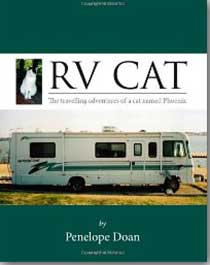 We Doans call writing “the family failing.” We all write, in one way or another. We can’t help it! In the past Penny has written gardening articles for magazines. Now she is the author of a charming book of photos and verse about those RV days, with Phoenix the heroine. You can see it on Amazon: RV Cat: The Travelling Adventures of a Cat Named Phoenix, by Penelope Doan.
We Doans call writing “the family failing.” We all write, in one way or another. We can’t help it! In the past Penny has written gardening articles for magazines. Now she is the author of a charming book of photos and verse about those RV days, with Phoenix the heroine. You can see it on Amazon: RV Cat: The Travelling Adventures of a Cat Named Phoenix, by Penelope Doan.
Nowadays Penny has two dogs, a Scottish terrier named Skye and a bichon frise named Paris. And, needless to say, she has a cat. Named Princess Tiger Lily.
© 2013 by Ruth Doan MacDougall; all rights reserved
FAVORITE BOOKS
January 13, 2013
“Of the books you’ve written, what’s your favorite?”
It’s a question I’m apt to get during Q&A when I give a talk, and like most writers I reply that I can’t really answer except to say it’s the book I’m working on. Unfinished, still full of boundless possibilities, the work in progress occupies my mind and it’s the workthat I love.
People also ask me what are my favorite books by other writers. I start off by saying my father’s books, of course. Then I think over the other books I reread often and I do my best to answer, hesitating because how do you choose some from so many? It’s as bad as any awards ceremony!
But when a friend, Jenny Stimac, wrote me asking this question, it occurred to me that writing makes me think more than talking does and thus it was high time I wrote down a list of the books that I reread over and over. So I did. Some of them I find myself wanting to reread for sheer pleasure; some, in addition to pleasure, have been important to me by providing lessons as I learned to write.
And here the list is, mostly in alphabetical order:
Cather, Willa: My Antonia
Doan, Daniel: The Crystal Yearsand Amos Jackman
Fitzgerald, F. Scott: The Great Gatsby
Jewett, Sarah Orne: The Country of the Pointed Firs
Maugham, W. Somerset: Cakes and Ale, or The Skeleton in the Cupboard
(one of my father’s favorite books, too)
Mitford, Nancy: The Pursuit of Love
Pym, Barbara:
ALL of her novels, but maybe particularly
Less than Angels and Quartet in Autumn
MacDonald, Betty: The Egg and I
Morley, Christopher: Kitty Foyle
The works of:
Agatha Christie
Ngaio Marsh
Dorothy L. Sayers
Mary Stewart
Josephine Tey
Also:
Paintbox Summer, by Betty Cavanna, a YA.
Adventures in English Literature, edited by J. B. Priestley and Josephine Spear, the textbook that Don chose for his senior English classes, a copy of which we keep close at hand for reference.
And three poetry books. Two are anthologies given to me by Jenny Stimac’s mother, Connie, when I was a girl:
Silver Pennies, by Blanche Jennings Thompson
The Pocket Book of Verse: Great English and American Poems,
edited by M. E. Speare
The third was given to me by Don in January 1957, when he was a sophomore in college and I was a senior in high school:
Collected Poems, by Edna St. Vincent Millay
2012
MARION'S CHRISTMAS SNOWBALL
November 23, 2012
When Snowy has supper for the first time at Tom’s house, the New England boiled dinner that his mother serves is exactly what Don’s mother, Marion, served the first time I was invited to Don’s house.
Marion was a very good cook. Her mother ran a boarding house in the Weirs, and that’s where Marion learned her repertoire, from meat loaf to liver and onions, from creamed cod to chicken pie. She was renowned for all her pies, apple, blueberry, custard, all of them. By the time I met Don, my mother had pretty much given up making pies from scratch and bought Table Talk, so I was very impressed, and in our early-married years I too made pies.
Marion was the kind of cook who didn’t need recipes and just winged it from memory. When I wanted to make Don’s favorite rolls of hers, bran rolls, I had to beg her to write down the ingredients and measurements for me. She eventually scribbled them down, but it was Don’s methodical father, Jim, who typed them up for me on a file card.
Her repertoire was, however, basic New England fare. So I was startled when, after Don and I were married and I became part of his family’s Christmas celebration, Marion didn’t serve a pie after the big turkey dinner; she served a glamorous dessert that she called a Snowball.
It was ambrosia!
She was never clear about where she got the recipe; probably she’d forgotten. Don remembers that his aunt was more experimental and wonders if Aunt Barbara might have seen it in a magazine and suggested it to Marion. In any case, the Snowball was in its way the best part of their family traditions, complicated as Christmases and families are. For Don the Snowball brings back the happiest memories.
After Jim died, Marion continued making Christmas dinners complete with the Snowball, even though the Snowball was becoming too big a chore for her. Fifteen years later when she moved into a nursing home and everyone realized this could be the end of the Snowball, Don’s sister and nieces tried to carry on the tradition, but it’s a lengthy recipe to cope with in a busy season. I’ve always meant to give it a try too; year after year I’ve resolved to.
Maybe this year?
And on the ell door’s window I hang a red Christmas stocking with jingle-bells trim, one of the two our grandmother made Penny and me. When Penny and I reminisce about Christmases past, we remember how Penny would come jingling into my bedroom with her red stocking early on Christmas morning before our parents were awake, and in my bed we’d open them together. There was always a tangerine in the toe.

Here is the Snowball recipe:
Marion’s Christmas Snowball
Combine:
1 ½ T. plain gelatin
4 T. cold water
1 c. boiling water
1 c. orange juice
juice of 2 lemons
1 c. sugar
Set in refrigerator until wiggly.
Whip:
1 pint heavy cream
Fold into gelatin mixture.
Remove brown crust from:
1 angel cake
Break cake into small pieces.
Put waxed paper in a bowl. Put in a layer of gelatin
and a layer of cake alternately until full.
Refrigerate overnight.
Whip:
½ pint heavy cream
Unmold snowball.
Cover with:
whipped cream
1 can coconut
Decorate with:
red and green maraschino cherries
And for a postscript, here’s my father’s recipe:
Dan’s Eggnog
Separate 6 eggs.
Beat the six egg yolks until light.
Beat in gradually:
½ c. sugar
Add by beating slowly:
1 c. whiskey (bourbon)
4 c. milk
To the egg whites add:
1/8 t. salt
Whip until stiff.
Fold whites gently into yolks mixture.
Serve with nutmeg sprinkled on
HAPPY HOLIDAYS!
A ROBIN SUMMER
September 17, 2012
Every March, Sally phones me from her home in South Carolina and says, “The robins have arrived and they’re getting drunk on fermented berries. Soon they’ll be on their way to New Hampshire!”
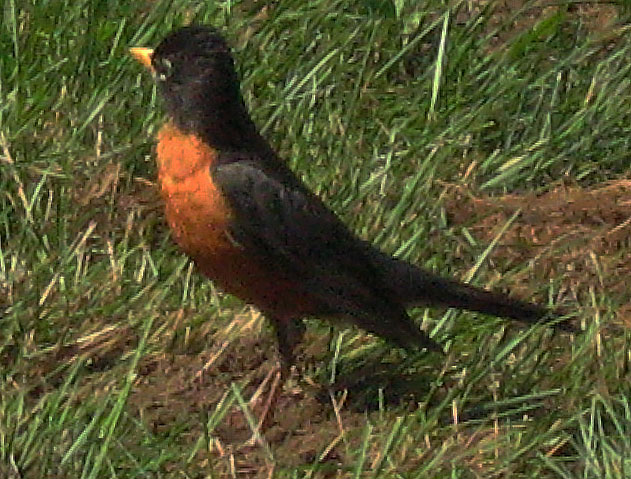 So I start waiting and watching—and remembering. When my sister, Penny, and I were children, every April we went with our parents down to Lexington, Massachusetts, to stay with our mother’s parents and see the parade on Paul Revere Day (now called Patriots’ Day). The parade was exciting, and our grandparents bought us balloons, but what has stayed with me most are robins. In New Hampshire the weather was still more winter than spring; in Massachusetts forsythia and daffodils bloomed bright yellow and robins were bouncing across the fresh green lawns. At our grandparents’ house, when Penny and I awoke in the mornings the singing of robins was what we heard first.
So I start waiting and watching—and remembering. When my sister, Penny, and I were children, every April we went with our parents down to Lexington, Massachusetts, to stay with our mother’s parents and see the parade on Paul Revere Day (now called Patriots’ Day). The parade was exciting, and our grandparents bought us balloons, but what has stayed with me most are robins. In New Hampshire the weather was still more winter than spring; in Massachusetts forsythia and daffodils bloomed bright yellow and robins were bouncing across the fresh green lawns. At our grandparents’ house, when Penny and I awoke in the mornings the singing of robins was what we heard first.
Ever since, when the robins do at last reach New Hampshire and I hear them burbling away first thing in the morning, I’m right back in that Lexington bedroom and a robin is singing outside the window. The same with Penny in Maine.
As our father explained to Penny and me, the American robin actually isn’t a robin at all. It’s a thrush. But because of its red breast, homesick colonists named it after the little European robin, who belongs to the flycatcher family. I accepted this bit of knowledge yet only really believed it years later when Don and I were living in England and we actually saw the adorable bird that makes the American robin look as ungainly as a crow.
Many years later, Sheena, a friend in Dingwall, Scotland, sent us a Christmas card with a European robin on it. I was so ecstatic about seeing one again that she subsequently sent us Christmas presents of a tray-and-coasters set decorated with robins and then a set of robin doilies. Treasures!
This spring, Don and I simultaneously asked each other, “Is it my imagination, or are we seeing more robins than usual this year?”
In recent years, because of climate change, we have seen an occasional robin in winter. Come spring this year, the robins arrived early, and they were everywhere in our yard. They liked to perch on the wooden stakes marking garden rows, they used the picnic table as an observation platform, and they were very interested in the loam Don spread on a sickly patch of lawn for grass-seed planting. The sound of their “cheer-i-lee” seemed almost constant. We ourselves had a tendency to sing “When the red red robin comes bob-bob-bobbing” a lot.
About robins’ songs: When I read up on robins in our bird books, I ran across this in Edward Howe Forbush’s Natural History of American Birds of Eastern and Central North America: “The songs vary considerably; the meter and rhythm of one song is imitated by the well-known words kill ’em, cure ’em, give ’em physic.” If I’d previously learned this delightful phrase, I’d forgotten it. It sounds almost like a Laconia High School cheer—“smash ’em, bust ’em, that’s our custom!”
We haven’t read in the news any ornithologist’s report on any extra abundance of robins this summer. So we just have our amateur impression.
Now, with the end of summer nearing, the robins have moved on and what we’re hearing most in our yard is the rattling call of the kingfishers as they land in trees and scan the beaver pond for a meal. We assume they’re having better luck than in years past, because the water is lower, giving frogs less cover.
For the beaver pond is entering another phase of its cycle. It started out as a small brook bordering our backyard, with woods down to its banks. Then the beavers moved in, building a dam that Don estimated to be longer than a football field, which created a string of four ponds. One of the lodges can be cozily seen from our kitchen windows and back porch. During the next twenty years, “Nature’s engineers” cut down most of the deciduous trees within beaver-traveling distance. (See my Neighborhood essay, “The End of Our Rope,” about how their efforts even included our clothesline.) Last year they realized they’d eaten themselves out of house and home, and they left. Without their maintenance of the dam, the pond is draining away. According to what I’ve read about the cycle, the pond will become a meadow, in which saplings will eventually grow, and someday the beavers will return and cut down the new trees for sustenance and material to repair the dam . . .
We miss the beavers. A muskrat has taken over the lodge. We’ve named him Jerry Muskrat a la Mother West Wind, and we watch him swimming along, dragging a little leafy branch into the lodge through the beavers’ old entrance, but it’s not the same.
Looking back at what we’re now calling a robin summer, we remember other sights this summer, especially these two:
In early spring we’d begun bringing in the birdfeeders at night but we couldn’t yet make ourselves bring them in during the daytime and give up the pleasure of watching the birds. What, not see birds on the feeders until the bears were hibernating again?! We procrastinated, as usual. So one evening in May, just as Don was washing the supper dishes before going outdoors to bring in the feeders, he looked out the kitchen window and saw a bear suddenly there, a few feet away, knocking over the birdfeeder pole. I eeked. Don ran out to the porch. He had prepared for bears this year by buying a new weapon with which to make noise, instead of the deafening old brass dinner bell my mother had rung to call my father in from the north forty in their farming days. On the porch, waiting for just this moment, was his purchase, an air horn, alongside his ear protectors. He donned (sorry, can’t resist that pun) the latter and began blasting away. The air horn was far more than deafening. It was painful. I of course wasn’t wearing ear protectors and leapt out of my skin. The bear took off partway into the woods and then paused to consider returning. Don blasted some more, and the bear skedaddled for good. We sadly brought the feeders indoors and put them away until late fall or early winter, however long we can wait.
The other wildlife sighting: In June, at about six in the morning, I glanced up from the kitchen sink and saw the backyard filled with a moose, very black-looking in the wet green morning. He meandered on to the beaver pond and partly waded, partly swam across to the opposite bank and continued his leisurely way up the slope into the woods. We could clearly watch his progress because the beavers had cleaned out all the trees except the pines up to the top of the slope.
One creature we looked for throughout the summer was one we had seen for the first time in our lives a year ago. On a June evening we’d heard the strangest sound, a mechanical noise like great gulping. I said, “It’s the sump pump strangling!” Don patiently explained that it wasn’t coming from the vicinity of the sump pump in the cellar. It was coming from outdoors, from the swampy part of the beaver pond. But we couldn’t see what on earth it was. So I decided it must be the Creature from the Black Lagoon.
A couple of days later we heard the noise again and scanned the pond—and Don, with a chill, saw a face looking back at him from the swamp. A bird face. A very peculiar bird face. By the time he pointed for me to look, it was gone.
We consulted our bird books and Don realized that he’d been lucky enough to see a rare sight, an American bittern. We learned that Thoreau had called the bittern “the genius of the bog.” Forbush wrote that “It is so inconspicuous and ordinarily keeps so much in hiding by day and its loud ‘love notes’ so much resemble the rural sounds of pumping and stake-driving that it is rarely noticed except by people who are much afield in its haunts . . Thoreau wrote ‘the Bittern pumps in the fen.’ What a story those few words tell! Again he remarks that the bird’s notes sound ‘as if he had taken the job of extending all the fences up the river to keep the cows from straying.’”
About the peculiar face Don had seen, Forbush wrote, “At the moment of emitting his dolorous love-song the violent contortions of the Bittern simulate those of a nauseated person in the very act of retching; yet the bird is not regurgitating food but apparently inflating its gullet with air.”
Other books described the noise as “booming” or “belching.” We’d heard a bittern belch!
The next evening, after supper, we heard that sound again. A large bird flew off from the pond, not as big as a heron but bigger than a duck. A bittern! Then the sound came again from that same spot. There must be two of them, courting.
Don walked stealthily across the lawn, studied the scene, beckoned to me. I tiptoed to join him.
He said, “See the big rock across the pond? See the dead branch curving back from it?”
I zeroed in on the bird before Don finished saying, “—it’s in the curve of the branch.”
The bird looked slim, brown-yellowish. It was in profile to us. And then we saw it begin opening its beak. The gulping sound echoed across the pond.
Alas, that was the last time we saw or heard the bitterns last summer.
And we never saw or heard them this summer. But we sure did see and hear robins.
NIOBE
July 10, 2012
I first heard about the repair of the Niobe statue from Geoff Burrows, our mailman, when he pulled up to our mailbox just as I was returning from a walk down the road. A Sandwich native, Geoff is also the president of the Sandwich Historical Society and a fascinating authority on the town, his knowledge deep.
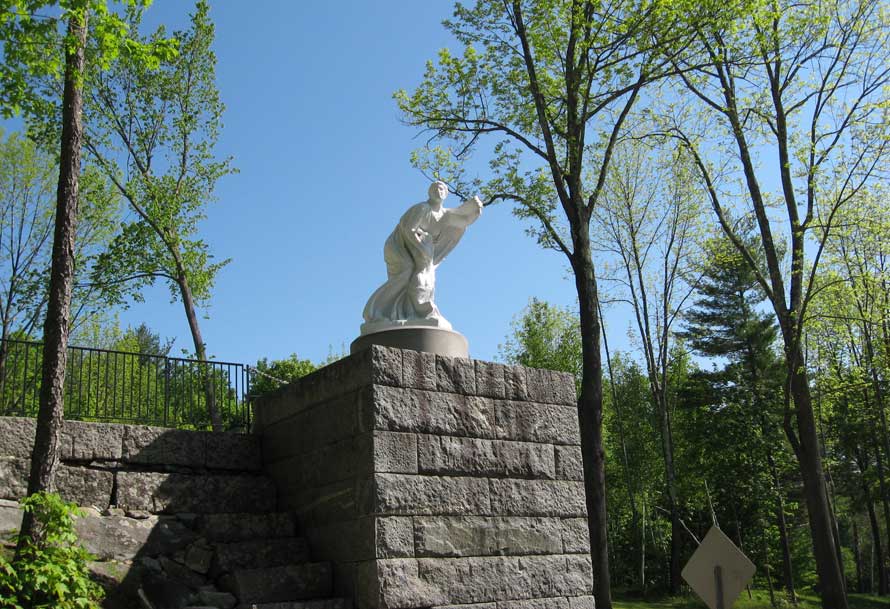 It was an early spring day, bleak but promising. As I stood there learning from him about the historical society’s unveiling event scheduled for true spring, May twelfth, I tried to remember the Niobe myth, but I could only recall children and weeping.
It was an early spring day, bleak but promising. As I stood there learning from him about the historical society’s unveiling event scheduled for true spring, May twelfth, I tried to remember the Niobe myth, but I could only recall children and weeping.
So after I came indoors and wrote the date on the calendar, I looked up the Niobe myth. She was the daughter of King Tantalus and became queen of Thebes when she married Amphion. She and Amphion had fourteen children, seven sons and seven daughters. She was proud of her status and of her children; too proud.
n the feast day of the goddess Leto, Niobe boasted about her rank and particularly her fourteen children, scorning Leto as inferior to her because she had only two children. These two children were the sun god Apollo and the moon goddess Artemis (Diana). Leto took revenge for Niobe’s insults: she sent Apollo and Artemis to kill Niobe’s children, which they sure did, slaughtering all fourteen with arrows. Niobe’s husband committed suicide. Niobe was turned into stone, in which state she was doomed to weep forever.
I suddenly remembered that I’d seen on the calendar that the day after the Niobe event was Mother’s Day. What a coincidence!
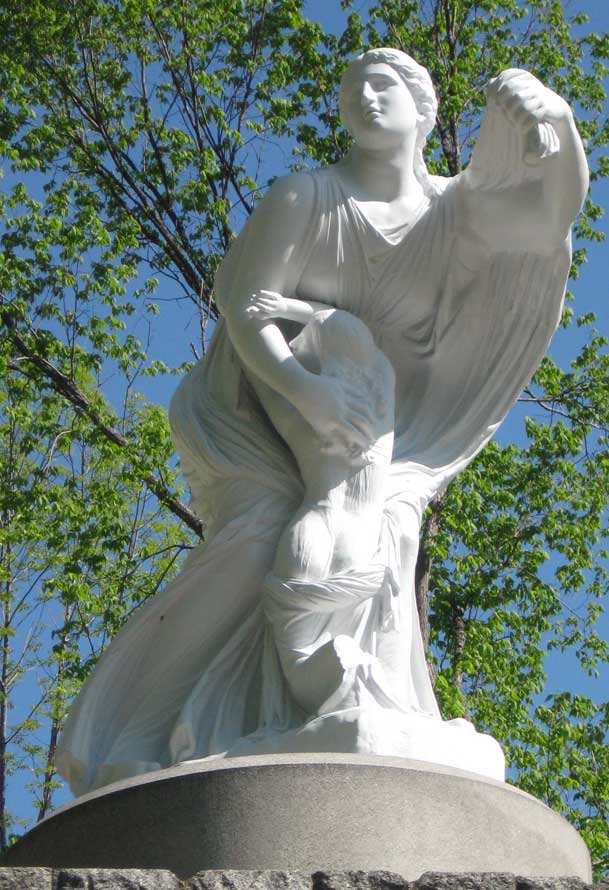 OMay twelfth proved to be the one beautiful sunny day in a long rainy spell, with the delicate chartreuse of the new leaves changing to lush green, and the town turned out in full force. The historical society by then had sent out an announcement about the event, asking us to park in various spots atop Wentworth Hill and to bring lawn chairs. This we all did, and, after milling around and chatting we sat down in the sun on the sloping green lawn of Adams Hall, with the Ossipee Mountains in front of us. Then the present owner of Adams Hall removed a covering to reveal the restored zinc statue of Niobe.
OMay twelfth proved to be the one beautiful sunny day in a long rainy spell, with the delicate chartreuse of the new leaves changing to lush green, and the town turned out in full force. The historical society by then had sent out an announcement about the event, asking us to park in various spots atop Wentworth Hill and to bring lawn chairs. This we all did, and, after milling around and chatting we sat down in the sun on the sloping green lawn of Adams Hall, with the Ossipee Mountains in front of us. Then the present owner of Adams Hall removed a covering to reveal the restored zinc statue of Niobe.
Adams Hall is part of the estate that in the 1800s Isaac Adams established when, after leaving Sandwich as a penniless young man to seek his fortune in Boston, he returned rich, having invented a steam-powered printing press.
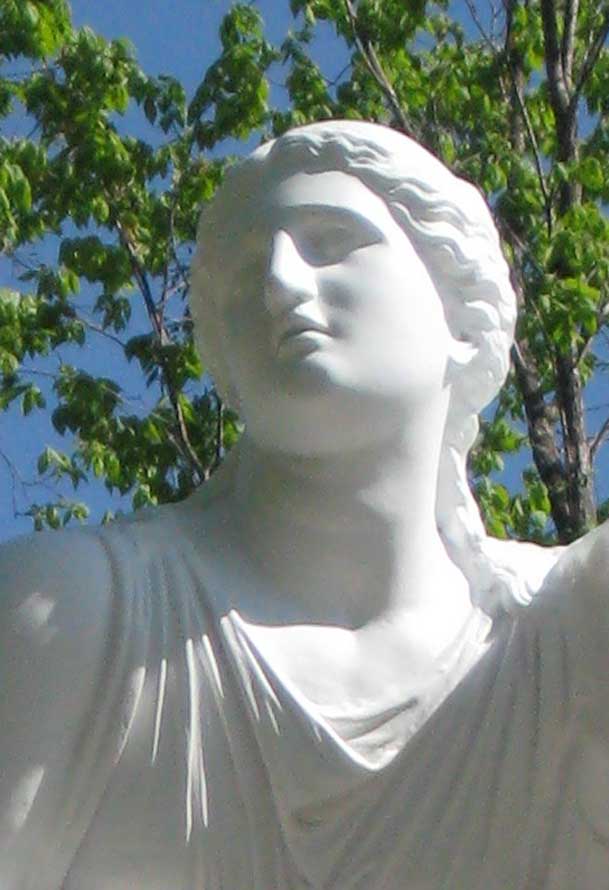 When Isaac Adams had left Sandwich, he left pissed off. He’d needed money to pay his coach fare to Boston but nobody in town would lend it to him because, they told him, he was of “no account” and they’d never get their money back. And that’s why, it’s speculated, he chose a statue of Niobe to adorn the grounds of Adams Hall: he was reminding the townsfolk of the perils of pride, of hubris. And like Leto and Apollo and Artemis he took his revenge. He bought up and tore down his neighbors’ farms, using some of the granite foundations to build what’s now known as the Great Wall of Sandwich around his property.
When Isaac Adams had left Sandwich, he left pissed off. He’d needed money to pay his coach fare to Boston but nobody in town would lend it to him because, they told him, he was of “no account” and they’d never get their money back. And that’s why, it’s speculated, he chose a statue of Niobe to adorn the grounds of Adams Hall: he was reminding the townsfolk of the perils of pride, of hubris. And like Leto and Apollo and Artemis he took his revenge. He bought up and tore down his neighbors’ farms, using some of the granite foundations to build what’s now known as the Great Wall of Sandwich around his property.
But Mother Nature can take revenge too. After Niobe had stood on her pedestal from 1875 to 1941, she fell during a storm and broke into nearly two hundred pieces. The pieces were saved, albeit in an ignominious place—when Adams Hall was bought by the present owners in 2004, Niobe was found in a barn under a pile of manure.
Then in 2010 Adam Nudd-Homeyer, a metal artisan and interim director of the historical society, saw the shattered statue and realized it was made of zinc. As he told the audience at the event, “I thouht to myself: I’m a metal worker; it’s made of metal. There’s got to be a way to do this.” And after over four hundred hours of work, he restored Niobe. He spoke about the role of coincidence in all this, from the coincidence of his moving to Sandwich to the coincidence of the statue’s toppling in just the right manner so that her face escaped destruction.
The Mother’s Day coincidence again occurred to me.
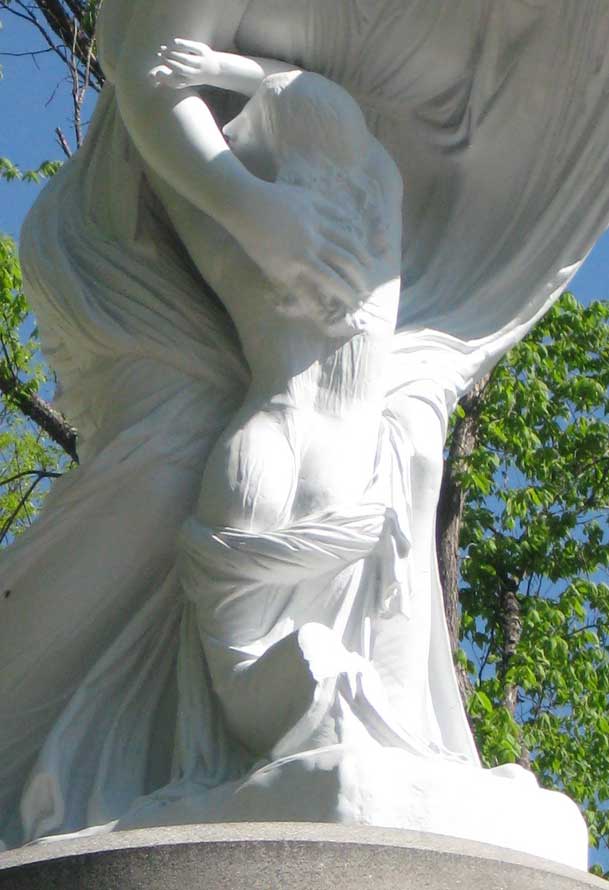 Geoff also spoke at the event, linking the past and present in his vivid way. He recalled that in his childhood people still referred to this hillside as “Image Hill.”
Geoff also spoke at the event, linking the past and present in his vivid way. He recalled that in his childhood people still referred to this hillside as “Image Hill.”
The last speaker was Carol Grissom, Senior Objects Conservator at the Smithsonian and authority on zinc statuary, whom Adam Nudd-Homeyer had consulted during his work. She explained that “zinc always imitated something else.” Sometimes it was painted white to pretend to be marble, as in the case of Niobe, or sometimes it imitated bronze. Niobe was probably cast by Prussian sculptor Moritz Geiss circa 1860, using a plaster mold taken from a statue of Niobe at the Uffizi Gallery in Florence.
Since the event, Don and I find ourselves detouring onto Little Pond Road to drive down the hill to see the statue. With Niobe once again standing here, it definitely can be called “Image Hill” again.
© 2012 by Ruth Doan MacDougall; all rights reserved
REMEMBERING MOTHER WEST WIND
April 25, 2012
In March this year we had a week of summer, when the temperature rose to eighty degrees and the ice that covered the beaver pond in our backyard began to melt. One day Don glanced out the kitchen window, saw splashing in the melted area, hollered for me, and we watched a sleek round head appear.
I said, “That’s Little Joe Otter!”
The name always comes to me automatically whenever we see an otter, because the first otter I ever met was in the pages of a Mother West Wind book and his name was Little Joe.
Don said, “Look.”
Another head popped out of the water. More splashing, much play.
Long ago I had learned from Thornton Burgess in his Mother West Wind books that otters love to frolic. They sure do. In winter we’ve even watched them go watersliding down an icy bank into a pool of open water near the shore, just like the mud-bank sliding I recall that Little Joe did.
Today, these two otters now climbed up on the ice. Don asked, “What’s the name of the other one?”
As usual I told him that if there was any otter in Mother West Wind other than Little Joe, I couldn’t remember.
But I could remember some of the other names in the Mother West Wind series that our grandparents gave my sister and me, books that were first read to us by our parents and then read by us on our own. A skunk to me will always be Jimmy Skunk. A mink is Billy Mink. A fox is Reddy Fox. A breeze is one of the Merry Little Breezes.
Besides these books, I also read about the Mother West Wind world in Thornton Burgess’s column in my mother’s Boston Globe. My friend Gwen’s memories go back into the past even deeper, for she is ninety-eight and remembers as a child reading the Burgess stories in her father’s Boston Herald.
After Don’s question, I wanted to refresh my memory about names, but the books from childhood were long gone, so until I could get to the library to see what they had I went online and rediscovered Jerry Muskrat, Paddy the Beaver, Johnny Chuck, Bobby Raccoon, Chatterer the Red Squirrel, Danny Meadow Mouse, Tufty the Linx, Hooty the Owl, Blacky the Crow, Sammy Jay, et al. (In my childhood, did it strike me that this was a boys’ club of creatures? If so, I accepted it. Wasn’t The Wind in the Willows peopled by Mole, Ratty. Mr. Toad, and Mr. Badger? But the books I remember rereading most often had heroines, from Raggedy Ann to Alice and Wendy.)
Names. Did Mother West Wind names inspire me to name the other creatures I encountered throughout my life, or is this simply a natural tendency to anthropomorphize?
Elsewhere in my “Neighborhood” and “Mailbox” pieces (“Making Tracks”; “Where That Barn Used to Be”), I’ve written about naming places, and other names have cropped up in the “Neighborhood,” such as Mother Goose and Father Goose for the Canada geese who attempted to nest on our abandoned beaver lodge last spring. In one of my novels I mentioned Stumpy, a chipmunk who’d lost part of her tail; she resided near our house where each spring we could watch her latest batch of babies venture out to the shock of daylight.
One year she had five babies!
The chipmunk we’ve been watching most closely lately we named Lily when we noticed her last summer, because she dug her burrow in the patch of lilies of the valley in our ell dooryard, near the house foundation. Well, not just one hole appeared amongst the lily leaves but many, as if she were creating a McMansion underground. Don the Scot who has to understand how things work, including chipmunk brains, spent a considerable amount of time trying to figure out what the hell she was up to, while I just marveled at the mounds of dirt she dug out. How could somebody so wee move so much earth?
Late in November we watched Lily rolling her bedroll; that is, rolling dry leaves into her mouth and taking them down to her burrow. Soon we didn’t see her again, but we thought of her down there snoozing through the winter under the lily roots. Then during March she reappeared and began scampering around, which made us wonder if she really was a Lily, for from our reading we gather that it’s the males who awake early in the spring to go a-courting. But this year, with summer in March, were all the chipmunks confused? Chipmunk babies are usually born in April and emerge from the burrow a month later, so we’re waiting to see if any will be exploring the lilies of the valley. If no babies do appear, we probably should change Lily’s name to Lyman, which, according to my names book, means “from the valley.”
Speaking of Mother and Father Geese a few paragraphs ago: On the last day of March this year we noticed two Canada geese in the best sunny spot in the pond, apparently soaking up some rays. Canada geese mate for life; could this be the pair who tried nesting here last year? That had been in May. They were early this year. Were they also confused? A few days later we saw them climb up onto the beaver lodge, onto the exact place where the nest had been. We know Canada geese can be an awful nuisance and even dangerous (such as causing a plane to have to be landed on the Hudson River), but we get so few in our pond that we can enjoy them. They’re still here, and we’re hoping this year they’ll truly be Mother Goose and Father Goose with goslings, which my friend Gloria, who has seen such youngsters, calls little dust mops.
We find that we’re less likely to name birds, maybe because it’s hard to sort out individuals, but last year there was one hummingbird who always chose one particular teeny-tiny twig to alight on in the lilac bush near the hummingbird feeder. She was a female and we named her Twiggy. Thus a hummingbird brought back to us our years of 1964 to 1966 in England when London was Swinging London and I kept hemming my skirts shorter and shorter.
Don has a general name for our fine feathered friends. Years ago we lived in a second-floor apartment in an old Victorian house in Dover, New Hampshire, where, off the kitchen, on the deck built on the roof of the porch below, we had a birdfeeder to which a surprising variety of birds came. One Saturday afternoon Don lugged a fifty-pound bag of sunflower seeds from our car to the porch, across the hallway, up the long flight of stairs, through our living room and dining room into the kitchen, and dropped it with a resounding thud to the floor.
“There!” he said. “That ought to hold the Little Bastards.”
Not a name I learned from Thornton Burgess.
© 2012 by Ruth Doan MacDougall; all rights reserved
NEIGHBORHOOD STOVES
February 8, 2012
The other day a new acquaintance stopped by, entering by the kitchen door, not the front door, of course. Then she stood stock-still and asked, “Is that one of those stoves that’s a heater?”
Don said proudly, “A Magee.”
She said, “We’ve got one at our camp. It came with the camp when we bought the place. I’ve never ever seen another one.”
Don and I laughed, and Don said, “Our neighborhood is full of them!”
He exaggerated a bit, but . . .
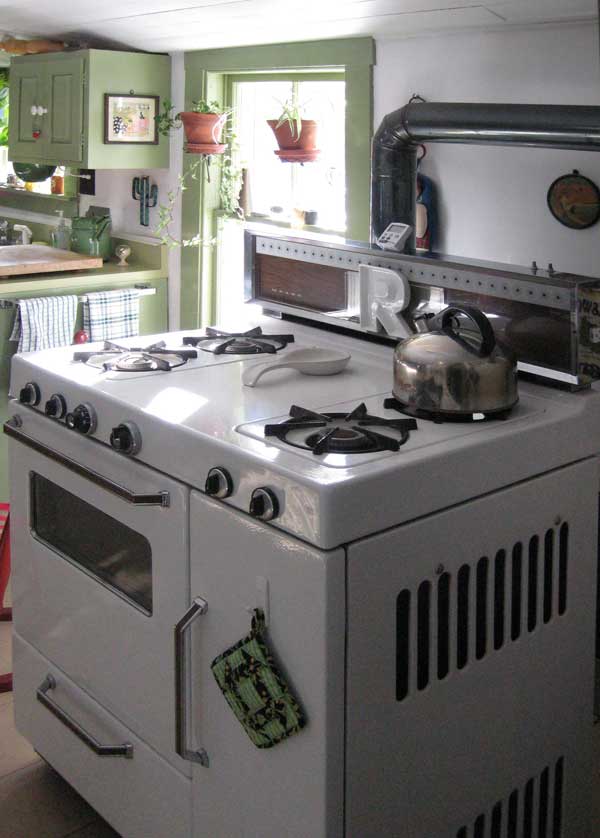
The house we moved into in Sandwich in 1976 consisted of a small shack built in the 1920s (judging by the newspapers we found for insulation above the ceiling), onto which in the 1960s a Cape had been built by new owners. They only used the house rarely, in the summer. The Cape was a shell, had never been wired for electricity, and the oil furnace had been drowned in a spring flood; Don wired the house, had a chimney built, and installed a woodstove in the living room to heat the Cape part of the house. The shack, which had become an ell after the addition of the Cape, contained the house’s plumbing, and for heat as well as for cooking there was a big cast-iron range that had been converted to oil from wood.
Much of this situation was the inspiration for the trials and tribulations in one of my novels, A Lovely Time Was Had by All.
I learned to enjoy cooking on the oil range, and I loved drying mittens on its shelf, but it had plenty of drawbacks, such as the price of the kerosene it used and its habit of freezing up on cold winter nights. Picture valiant Don in bathrobe, parka, and boots, outdoors with a flashlight and a boiling teakettle, thawing the line from the oil barrel to the house!
Other houses in our neighborhood had normal kitchen stoves, gas or electric. But three of our neighbors—the Jacksons, Marcia, and Lib—had an updated version of the black iron range, a white enamel gas range that also served as a space heater in their kitchens. The lettering on the stoves said that they were made by Magee. The first time we saw one of these stoves, which happened to be the Jacksons’, we were seized by Magee-stove envy.
In 1985 the Jacksons sold their house and moved to a retirement home. The new owners moved in, and we all introduced ourselves. It didn’t occur to us to ask what they were going to do with the Magee, because we assumed they would want to keep such a treasure. Then one day Don happened to notice while driving past that they had lugged the Magee out of the house to the barn as if they were going to get rid of it. He overcame the Yankee diffidence in his soul and swung into their driveway, jumped out of his pickup, and banged on their door to inquire. Yes, they said, they were redoing the kitchen and replacing the stove with a modern one. No, we couldn’t buy it from them; they would give it to us for taking it away and saving them a trip to the dump!
So, with help from friends, we loaded it into the pickup and brought it down the road to its new home. Don took it all apart, cleaned every single inch, and reassembled it in the kitchen. We moved the oil range into the dining room, where it remained for several years as a sort of sideboard until we convinced a high-school classmate of mine who was in the antiques business to cart it off; we had got the Magee free, and we passed along the oil range free to him for the lugging.
Don likes everything to work. He got the Magee functioning better than it probably ever had in decades, but he could not make its clock go, which bothered him. I was too happy with my “new” stove to care; what the hell, we could buy an oven timer at the hardware store. Don removed the clock, but the blank space bothered him, so he glued up a ceramic R that Penny, my sister, had given me as a reminder of the Mary Tyler Moore Show’s M that Mary put on a wall in her apartment. The Magee was acquiring even more personality. Its oven’s window was so etched with age that even Don’s intense scrubbing with various detergents could not clean it, but I didn’t care about that, either.
I was, however, taken aback when I realized that the oven ran fifty degrees hotter than the oven thermometer registered. Then I thought, again, what the hell. My days of tricky cooking were over, I wasn’t baking soufflés and popovers and cakes anymore, so all I had to do was remember to set the oven fifty degrees lower than the recipe wanted and the macaroni and cheese would bake just fine. Of course I forgot at first, but there were no disasters.
Over the ensuing years, the Magee has continued to heat the kitchen, the bathroom/laundry room, and the third room in the ell, Don’s little office. When the power goes off during snowstorms, it has kept the ell warm and the plumbing from freezing. Yet it has had its ailments, through which Don and our gas-company repairman have nursed it. Occasionally we think we should look into some more up-to-date method of heating the ell and we investigate, but every other choice leaves us stymied, mainly because most modern gas heaters have to be started by electricity. Catch-22: If the power goes off, the gas heater won’t work.
Gradually one worry loomed larger during the years. If we were going to have to keep using the Magee forever, how would we? Where would we find parts?
Then a few years ago Lib decided it was time for a convenient new stove. Knowing about our worry, she offered us her Magee. Joy! Don immediately phoned the gas-company repairman, who, with a helper, came to Lib’s house, picked up the stove, drove it to the gas-company place, and took it to pieces, saving everything they thought our Magee might need in the future.
These pieces are now stored in our cellar, giving us a secure feeling rather like that given me by, back in my canning days, the jars of soups and pickles on our cellar shelves.
Thus we have two of the three neighborhood stoves, one intact, one in pieces. Someday we may make inquiries about that third one, just in case . . .
© 2012 by Ruth Doan MacDougall; all rights reserved
Archive of Past Entries
2025
Red-Flannel Hash, Etc.
Family Recipes
Wider Eyelids
Donuts After Dartmouth
Castle in the Clouds
Dan Doan's Birthday
File Folders
Chocolate Lovers' Month
Piano Songs
Titles
Velveeta, etc.
Sandwich Board Greets 2025
Words
2024
PW 2025 Spring Preview
Christmas Vacation
Songs
D-H Trip
Gatsby & Icarus & Pudding
Yankee
Sides
E-BLAST and Sandwich Board
Sentimental Journey
Announcement & Creme Tea
Rosemary Schrager
British Picnic
Fall Food
September Sandwich Board
Soap and Friends
Autumn Anxiety
From Philosophy to Popsicles
Cheat Day Eats
Meredith NH
1920s Fashions
Old Home Week 2024
Honor System
Lost . . .Found . . .
Picnics
Aunt Pleasantine
Best of New Hampshire
Soup to Doughnuts
Tried and True Beauty. . .
A Shaving Horse, Etc.
Farewell, Weirs Drive-In
Backyard Sights
Thoreau and Dunkin’ Donuts
Cafeteria-and-Storybook Food
Lost and Found
Dandelions and Joy
Fiddleheads and Flowers
Pass the Poems, Please
Pete
Road Trip
Reviews and Remarks
Girl Scouts
Board, Not Boring
Postholing & Forest Bathing
Chocolate
PW's Spring Previews
From Pies to Frost
Island Garden
More Sandwich Board
Nancy
2023
Spotted Dick
Dashing Through the Cookies
Chocorua
Senior Christmas Dinner
The Sandwich Board
Nostalgia
Socks, Relaxation, and Cakes
Holiday Gift Books
Maine
Cafeteria Food; Fast Food
Happy 100th Birthday, Dear LHS
Giraffes, Etc.
A Monday Trip
Laconia High School, Etc.
Christmas Romance
National Potato Month
Globe
Preserving With Penny
Psychogeography
Bayswater Books
"Wild Girls"
Kitchens
Old Home Week
The Middle Miles
Bears, Horses, and Pies
Fourth of July 2023
Lucy and Willa
Frappes, Etc.
Still Springtime
In the Bedroom
Dried Blueberries
More Items of Interest
Fire Towers
Anne, Emily, and L.M.
Earthquake,Laughter, &Cookbook
Springtime and Poems
Cookbooks and Poems
Items and Poems
Two Pies
Audiobooks
The Cheeleader: 50th Anniversary
The Lot, Revisited
Penny
Parking and Other Subjects
Concord
Bird Food & Superbowl Food
The Cold Snap
Laughter and Lorna
Tea and Digestive Biscuits
Ducks, Mornings, & Wonders
Snowflakes
A New Year's Resolution
2022
Jingle Bells
Fruitcake, Ribbon Candy &Snowball
Christmas Pudding
Amusements
Weather and Woods
Gravy
Brass Rubbing
Moving Day
Sandwiches and Beer
Edna, Celia, and Charlotte
Sandwich Fair Weekend
More Reuntions
A Pie and a Sandwich
Evesham
Chawton
Winter's Wisdom?
Vanity Plates
2022 Golden Circle Luncheon
Agatha and Annie
National Dog Month
The Chef's Triangle
Librarians and Libraries
Clothes and Cakes
Porch Reading
Cheesy!
The Summer Book
Bears Goats Motorcycles
Tuna Fish
Laconia
More Publishers Weekly Reviews
Shopping, Small and Big
Ponds
The Lakes Region
TV for Early Birds; An April Poem
Family; Food; Fold-out Sofas
Solitary Eaters
National Poetry Month
Special Places;Popular Cakes
Neighborhood Parks
More About Potatoes and Maine
Potatoes
Spring Tease
Pillows
Our Song
Undies
Laughter
A Burns Night
From Keats to Spaghetta Sauce
Chowder Recipes
Cheeses and Chowders
2021
The Roaring Twenties
Christmas Traditions
Trail Cameras
Cars and Trucks
Return?
Lipstick
Tricks of the Trade
A New Dictionary Word
A 50th Reunion
Sides to Middle" Again
Pantries and Anchovies
Fairs and Festivals
Reunions
A Lull
The Queen and Others
Scones and Gardens
Best Maine Diner
Neighborhood Grocery Store; Café
A Goldilocks Morning_& More
Desks
Sports Bras and Pseudonyms
Storybook Food
Rachel Field
The Bliss Point
Items of Interest
Motorcycle Week 2021
Seafood, Inland and Seaside
Thrillers to Doughnuts
National Trails Day
New Hampshire Language
Books and Squares
Gardening in May
The Familiar
Synonyms
"Bear!"
Blossoms
Lost Kitchen and Found Poetry
More About Mud
Gilbert and Sullivan
St. Patrick's Day 2021
Spring Forward
A Blank Page
No-Recipe Recipes
Libraries and Publishers Weekly
Party; Also, Pizza
Groundhog Day
Jeeps
Poems and Paper-Whites
Peanut Butter
Last Wednesday
Hoodsies and Animal Crackers
2020
Welcome, 2021
Cornwall at Christmastime
Mount Tripyramid
New Hampshire Pie
Frost, Longfellow, and Larkin
Rocking Chairs
Thanksgiving Side Dishes
Election 2000
Jell-O and Pollyanna
Peyton Place in Maine
Remember the Reader
Sandwich Fairs In Our Past
Drought and Doughnuts&
Snacks
Support Systems, Continuing
Dessert Salads?!
Agatha Christie's 100th Anniversary
Poutine and A Postscript
Pandemic Listening & Reading
Mobile Businesses
Backyard Wildlife
Maine Books
Garlic
Birthday Cakes
A Collection of Quotations
Best of New Hampshire
Hair
Learning
Riding & "Broading" Around Sunday Drives, Again
The Passion Pit
Schedules & Sustenance
Doan Sisters Go to a British Supermarket
National Poetry Month
Laconia
Results
Singing
Dining Out
Red Hill
An Island Kitchen
Pandemic and Poetry
Food for Hikes
Social Whirl in February
Two Audiobooks & a Magazine
Books Sandwiched In
Mailboxes
Ironing
The Cup & Crumb
Catalogs
Audiobook Travels
2019
Christmas Weather
Christmas in the Village
Marion's Christmas Snowball, Again
Phyliss McGinley and Mrs. York
Portsmouth Thanksgiving
Dentist's Waiting Room, Again
Louisa and P.G.
The First Snow
Joy of Cooking
Over-the-Hill Celebration
Pumpkin Regatta
Houseplants, New and Old
Pumpkin Spice
Wildlife
Shakespeare and George
Castles and Country Houses
New Hampshire Apple Day
Maine Woods and Matchmaking
Reunions
Sawyer's Dairy Bar
Old Home Week
Summer Scenes
Maine Food
Out of Reach
This and That, Again
The Lot
Pizza, Past and Present
Setting Up Housekeeping
Latest Listening and Reading
Pinkham Notch
A Boyhood in the Weirs
The Big Bear
It's Radio!
Archie
Department Stores
Spring Is Here!
Dorothy Parker Poem
National Library Week, 2019
National Poetry Month, 2019/a>
Signs of Spring, 2019
Frost Heaves, Again
Latest Reading and Listening
Car Inspection
Snowy Owls and Chicadees
Sandwiches Past and Present
Our First Date
Ice Fishing Remembered
Home Ec
A Rockland Restaurant
Kingfisher
Mills & Factories
Squirrels
2018
Clothesline Collapse
Thanksgiving 2018
Bookmarks
A Mouse Milestone
Farewell to Our Magee
Sistering
Sears
Love and Ruin
A New Furnace
Keene Cuisine
A Mini-Mini Reunion
Support System
Five & Ten
Dining Out Again
Summer Listening
Donald K. MacDougall 1936-2018
Update—Don
Telling Don
Don's Health
Seafood at the Seacoast?
Lilacs
Going Up Brook, revisited
The Weirs Drive-In Theater
The Green and Yellow Time
Recipe Box and Notebook
Henrietta Snow, 2nd Printing
Food and Drink Poems
Miniskirts & Bell-Bottoms
The Poor Man's Fertilizer
The Galloping Gourmet
The Old Country Store
The entries below predate Ruth's transferring her use of Facebook. They appeared as very occasional opportunities to share what was of interest to her in and around her neighborhood.
2014 - 2017
Book Reviewing
April Flowers
April Snowstorm
Restoring the Colonial Theater
Reunion at Sawyer's Dairy Bar
Going to the Dump
Desks
A Curmudgeon's Lament
Aprons
Our Green-and-Stone-Ribbed World
Playing Tourist
2012-2013
Sawyer's Dairy Bar
Why Climb a MountIn
Penny'S Cats
Favorite Books
Marion's Christmas Snowball
Robin Summer
Niobe
Mother West Wind
Neighborhood Stoves
2008 - 2011
The Lot
Mother Goose
Colonial Theater
Aeons of Ironing
Our Canterbury Tale
Love it Here
Children of the Great Depression
Loads of Laundry
2004 - 2007
The Winter of Our Comfort Food
Rebuilding the Daniel Doan Trail
My Husband Is In Love with Margaret Warner
Chair Caning
The End of Our Rope
The Weirs
Frost Heaves
Where In the World is Esther Williams
The Toolshed
Sandwich Bar Parade
Lawns
2000-2003
That'll Do
Chipmunks and Peepers
A Fed Bear
Laconia HS 45th Reunion
Birdbrains
Drought
Friends
Wild Turkeys
Meadowbrook Salon
Lunch on the Porch
Damn Ice
A Male Milestone
1998-1999
Y2K
Fifties Diner
Glorious Garlic
Celebrated Jumping Chipmunk
Going Up Brook
Mud Season
BRR!
Vacation in Maine
Trip to Lancaster/Lisbon NH
Overnight Hike to Gordon Pond
Big Chill Reunion
Backyard Wildlife
Privacy Policy
This website does not collect any personal information. We do collect numerical data as to traffic to the site, but this data is not attached in any way to our visitors' personal or computer identities. Those clicking through to other websites linked from this page are subject to those sites' privacy policies. Our publisher, Frigate Books, maintains the same policy as this site; financial information submitted there is not shared with either Frigate Books or ruthdoanmacdougall.com.
